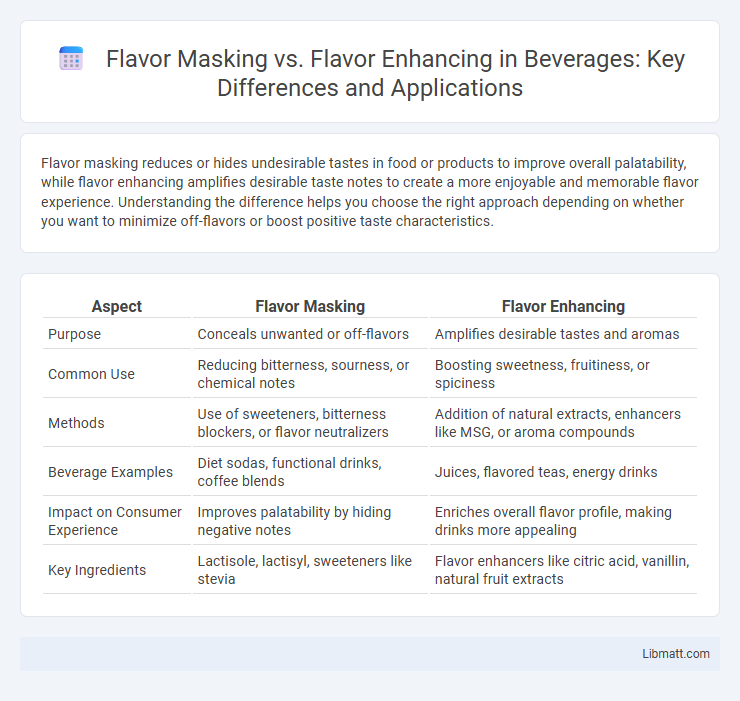Flavor masking reduces or hides undesirable tastes in food or products to improve overall palatability, while flavor enhancing amplifies desirable taste notes to create a more enjoyable and memorable flavor experience. Understanding the difference helps you choose the right approach depending on whether you want to minimize off-flavors or boost positive taste characteristics.
Table of Comparison
| Aspect | Flavor Masking | Flavor Enhancing |
|---|---|---|
| Purpose | Conceals unwanted or off-flavors | Amplifies desirable tastes and aromas |
| Common Use | Reducing bitterness, sourness, or chemical notes | Boosting sweetness, fruitiness, or spiciness |
| Methods | Use of sweeteners, bitterness blockers, or flavor neutralizers | Addition of natural extracts, enhancers like MSG, or aroma compounds |
| Beverage Examples | Diet sodas, functional drinks, coffee blends | Juices, flavored teas, energy drinks |
| Impact on Consumer Experience | Improves palatability by hiding negative notes | Enriches overall flavor profile, making drinks more appealing |
| Key Ingredients | Lactisole, lactisyl, sweeteners like stevia | Flavor enhancers like citric acid, vanillin, natural fruit extracts |
Understanding Flavor Masking and Flavor Enhancing
Flavor masking reduces or neutralizes undesirable tastes in food and beverages by using agents like sweeteners, bitterness blockers, or aroma modifiers to improve overall palatability. Flavor enhancing intensifies desirable flavors by incorporating compounds such as umami, salt, or natural extracts that amplify taste profiles and consumer appeal. Both techniques are essential in food technology to balance sensory experiences, optimize product quality, and meet specific dietary or formulation goals.
Key Differences Between Masking and Enhancing Flavors
Flavor masking and flavor enhancing serve distinct purposes in food and beverage formulation. Flavor masking involves suppressing or covering undesirable tastes, such as bitterness or off-notes, to improve overall palatability, while flavor enhancing amplifies desirable flavors to elevate the sensory experience. Your choice depends on whether you need to neutralize unpleasant tastes or intensify specific flavor profiles to achieve the desired product balance.
Common Applications in the Food Industry
Flavor masking is commonly applied in the food industry to conceal undesirable tastes in products such as protein supplements, pharmaceuticals, and fortified foods, ensuring a pleasant consumer experience. Flavor enhancing is widely used in snacks, beverages, and processed foods to intensify or highlight natural flavors, thereby improving taste appeal and product differentiation. Your choice between these techniques depends on the desired outcome: masking off-notes or amplifying existing flavors to meet consumer preferences.
Popular Ingredients Used for Flavor Masking
Popular ingredients used for flavor masking include activated charcoal, cyclodextrins, and certain types of gums such as xanthan and guar, which trap and suppress unwanted tastes in pharmaceuticals and food products. Bitter blockers like lactisole and hesperidin effectively reduce bitterness by interacting with taste receptors, enhancing overall sensory experience. These agents allow manufacturers to improve product palatability without altering the primary flavor profile.
Leading Flavor Enhancers and Their Uses
Leading flavor enhancers include monosodium glutamate (MSG), yeast extracts, and disodium inosinate, widely used to intensify savory, umami, and meaty notes in processed foods, soups, and snacks. These agents work by amplifying existing taste profiles without altering the inherent flavor, making them ideal for boosting palatability in low-sodium or bland products. Flavor masking agents, by contrast, specialize in neutralizing undesirable tastes such as bitterness or off-flavors, often used in pharmaceuticals and fortified beverages to improve consumer acceptance.
Impact on Consumer Perception and Acceptance
Flavor masking techniques reduce undesirable tastes in products, improving consumer acceptance by minimizing bitterness or off-flavors, especially in pharmaceuticals and functional foods. In contrast, flavor enhancing strategies amplify desirable sensory attributes like sweetness or umami, elevating overall flavor intensity and boosting positive consumer perception. Both approaches significantly influence product palatability, shaping consumer preference and repeat purchase behavior through targeted modification of flavor profiles.
Challenges in Achieving Effective Flavor Masking
Achieving effective flavor masking faces challenges such as overcoming the strong off-notes of bitter or metallic compounds often found in pharmaceuticals and nutritional supplements, which can dominate the overall taste profile. The complexity of the food matrix and interactions between flavor maskers and active ingredients require precise formulation techniques to ensure stability and efficacy without compromising texture or appearance. Advanced microencapsulation and controlled-release technologies are often necessary to address these challenges by selectively blocking unpleasant tastes while preserving desirable flavors.
Innovations in Flavor Enhancement Technologies
Innovations in flavor enhancement technologies have revolutionized the food and beverage industry by utilizing encapsulation, nanoemulsions, and biotechnological methods to amplify natural taste profiles without altering product composition. Advanced enzymatic and microbial processes enable targeted release of flavor compounds, improving sensory experiences while masking undesirable notes. These breakthroughs allow manufacturers to optimize flavor intensity and complexity, meeting consumer demands for healthier, cleaner-label products.
Regulatory Considerations for Flavor Modifiers
Flavor masking and flavor enhancing ingredients are subject to strict regulatory frameworks to ensure consumer safety and accurate labeling. Regulatory bodies like the FDA and EFSA require thorough evaluation of flavor modifiers for potential allergens, toxicology, and permissible usage levels. When selecting flavor modifiers for your products, compliance with these regulations is essential to avoid legal issues and maintain consumer trust.
Future Trends in Flavor Modulation
Emerging future trends in flavor modulation emphasize advanced flavor masking techniques using nanoencapsulation and biopolymer coatings to effectively suppress undesirable tastes in functional foods and pharmaceuticals. Flavor enhancing innovations increasingly utilize natural flavor enhancers derived from plant extracts and fermentation technology, optimizing flavor profiles while aligning with clean-label consumer demands. Integration of AI-driven flavor prediction models accelerates the development of customized flavor solutions, balancing masking and enhancing strategies for personalized nutrition and sensory experiences.
Flavor masking vs flavor enhancing Infographic

 libmatt.com
libmatt.com